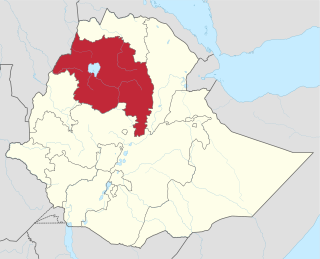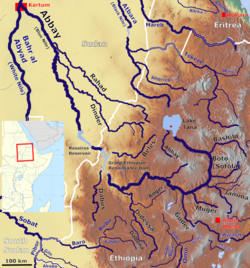
Wollo was a historical province of northern Ethiopia. During the Middle Ages this province name was Bete Amhara and it was the centre of the Solomonic emperors. Bete Amhara had an illustrious place in Ethiopian political and cultural history. It was the center of the Solomonic Dynasty established by Emperor Yekuno Amlak around Lake Hayq in 1270. Bete Amhara was bounded on the west by the Abbay, on the south by the river Wanchet, on the north by the Bashilo River and on the east by the Escarpment that separate it from the Afar Desert.

The Amhara Region, officially the Amhara National Regional State, is a regional state in northern Ethiopia and the homeland of the Amhara, Awi, Xamir, Argoba, and Qemant people. Its capital is Bahir Dar which is the seat of the Regional Government of Amhara. Amhara is the site of the largest inland body of water in Ethiopia, Lake Tana, and Semien Mountains National Park. Amhara is bordered by Sudan to the west and northwest and by other the regions of Ethiopia: Tigray to the north, Afar to the east, Benishangul-Gumuz to the west and southwest, and Oromia to the south. Towns and cities in Amhara include: Bahir Dar, Dessie, Gonder, Debre Birhan, Debre Tabor, Kombolcha, Weldiya, Debre Markos, Seqota, Kobo, and Metema.

North Wollo also called Semien Wollo, is a zone in Amhara Region of Ethiopia. It is bordered on the south by South Wollo, on the west by South Gondar, on the north by Wag Hemra, on the northeast by Tigray Region, and on the east by Afar Region; part of its southern border is defined by the Mille River. Its highest point is Mount Abuna Yosef. Its towns include Lasta Lalibela and Weldiya. North Wollo acquired its name from the former province of Wollo.

North Shewa is a zone in the Amhara Region of Ethiopia. North Shewa takes its name from the kingdom and former province of Shewa. The Zone is bordered on the south and the west by the Oromia Region, on the north by South Wollo, on the northeast by the Oromia Zone, and on the east by the Afar Region. The highest point in the Zone is Mount Abuye Meda, which is found in the Gish woreda; other prominent peaks include Mount Megezez. Towns in North Shewa include Ankober, Debre Birhan, and Shewa Robit.

East Gojjam, also called Misraq Gojjam, is a zone in Amhara Region of Ethiopia. Its capital is Debre Markos. East Gojjam is named after the former province of Gojjam.

The Oromia Zone is a zone in Amhara Region of Ethiopia. Oromia is named for the Oromo people, who settled along the edge of the Ethiopian Highlands that form this Zone. Oromia Zone is bordered on the southwest by North Shewa Zone, on the northwest by South Wollo and Argobba special woreda, and on the east by the Afar Region. The Zone consists of 7 Woredas which are Artuma Fursi, Bati, Bati Town, Dewa Cheffa, Dewa Harewa, Jilye Tumuga and Kemisie town. Kemise is the administrative center of the Zone.
Amhara Province also known as Bete Amhara was the name of a medieval province of the Ethiopian Empire, located in present-day Debub Wollo and parts of Semien Shewa. It was named after the Amhara people, who originated from the province.
Qwara is one of the woredas in the Amhara Region of Ethiopia. Qwara is named after the former province of Qwara, which was in the same area. Located at the westernmost point of the Semien Gondar Zone, Qwara is bordered on the south by the Benishangul-Gumuz Region, on the west by Sudan, on the north by Metemma, on the east by Takusa and Alefa, and on the southeast by Agew Awi Zone; part of its boundary with the Benishangul-Gumaz Region is defined by the Dinder River. The administrative center of this woreda is Gelegu; other settlements include Tewodros Ketema.
Meket is a woreda in Amhara Region, Ethiopia. It is named after a former district located approximately in this area. Located on the western side of the Semien Wollo Zone, Meket is bordered on the south by Wadla and Dawunt, on the west by the Debub Gondar Zone, on the northwest by Bugna, on the north by Lasta, on the northeast by Gidan, and on the east by Guba Lafto. The administrative center of Meket is Filakit Gereger; other settlements include Debre Zebit and Weketa.
Wadla is a woreda in Amhara Region, Ethiopia. It is named for the former district which lay roughly in the same area. Part of the Semien Wollo Zone, Wadla is bordered on the southeast by Delanta, on the southwest by Dawunt, on the north by Meket, and on the northeast by Guba Lafto. The major town in Wadla is Gashena. Other towns include Kone and Arbit.
Dawuntna Delant was one of the 105 woredas in the Amhara Region of Ethiopia. Part of the Semien Wollo Zone, Dawuntna Delant was bordered on the south by the Checheho River which separated it from the Debub Wollo Zone, on the west by the Debub Gondar Zone, on the north by Wadla, and on the east by Guba Lafto. The deep valley of the Zhit'a river, which runs through Wadla and along part of the northern border, effectively isolates much of Dawuntna Delant from the rest of Semien Wollo. This woreda was named after two historical districts, Dawunt to the east and Delanta to the west. The major town in Dawuntna Delant was Wegeltena. This woreda was separated for Dawunt and Delanta woredas.

Tenta is a woreda in Amhara Region, Ethiopia. Part of the Debub Wollo Zone, Tenta is bordered on the south by Legambo, on the southwest by Sayint, on the west by Magdala, on the north by the Bashilo River which separates it from Semien Wollo Zone, on the northeast by Ambassel, on the east by Kutaber and on the southeast by Dessie Zuria. The administrative center of this woreda is Ajebar; other towns in Tenta include Amba Mariam, and Tenta.
Sayint, or Amhara Sayint, is a woreda in Amhara Region, Ethiopia. It is named after the historical district of Amhara Sayint which was located in the same area. Part of the South Wollo Zone, Sayint is bordered on the south by Debre Sina and Mehal Sayint, on the west by the Blue Nile that separates it from the East Gojjam Zone, on the northwest by the Bashilo River that separates it from the South Gondar Zone, on the north by Magdala, on the east by Tenta and on the southeast by Legambo. The major town in Amhara Sayint is Ajibar. Mehal Sayint was created by separating it from the historic Amhara Sayint woreda.
Borena is a woreda in Amhara Region, Ethiopia. Formerly known as Debre Sina, this district lies in the western part of the Debub Wollo Zone. Borena is bordered on the south by Wegde, on the west by the Abbay River which separates it from the Misraq Gojjam Zone, on the north by Mehal Sayint, on the northeast by Sayint, and on the east by Legambo. The administrative center is Mekane Selam; other towns in Borena include Wobo Mikael.
Jama is one of the woredas in the Amhara Region of Ethiopia. Part of the Debub Wollo Zone, Jama is bordered on the southeast by the Qechene River which separates it from the Semien Shewa Zone, on the west by Kelala, on the north by Legahida, and on the northeast by Were Ilu. Towns in Jama include Dagolo, Faj, and Shul Afaf.
Gishe also spelled as Geshe is a woreda in Amhara Region, Ethiopia. Located at the eastern edge of the Ethiopian highlands in the Semien Shewa Zone, Gishe is bordered on the south by the Menz Gera Midir, on the west and north by the Debub Wollo Zone, and on the east by Antsokiyana Gemza; the Wanchet River defines its western boundary.
Mida Woremo is one of the woredas in the Amhara Region of Ethiopia. Part of the Semien Shewa Zone, Mida Woremo is bordered on the south by the Qechene River which separates it from Merhabiete, on the west by the Oromia Region, and on the north and east by the Debub Wollo Zone; the northern boundary is defined by the Walaqa River. The administrative center of this woreda is Meragna; other towns include Rema.

The Jamma River is a river in central Ethiopia and a tributary to the Abay. It drains parts of the Semien Shewa Zones of the Amhara and Oromia Regions. The Upper Jamma flows through steep, deep canyons cut first through volcanic rock and then through the Cretaceous sandstone and shaly sandstone, with Jurassic limestone at the bottom. It has a drainage area of about 15,782 square kilometers in size. Tributaries include the Wanchet.
The Walaqa River, a tributary of the Blue Nile, is a river in the Amhara Region of Ethiopia. Wegde is located to its north. Mida Woremo and Dera are to the south, while Kelala is to the northeast. The Walaqa River may have been the northern boundary of the historical province of Walaqa.
Mehal Meda is a town in Ethiopia situated in the Semien Shewa Zone of the Amhara Region. It has a geographical coordinates of 10° 18' 0" North, 39° 40' 0" East, with an altitude of 3132 m above sea level. The town is located 150 km north of Debre Berhan and 224 mi northeast of the capital Addis Ababa.







